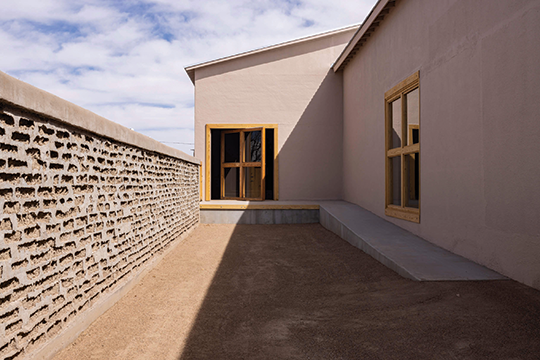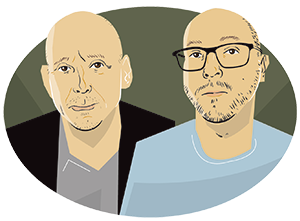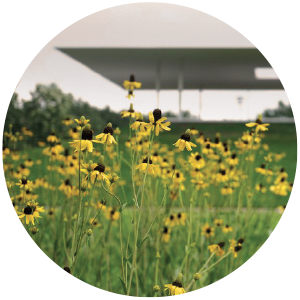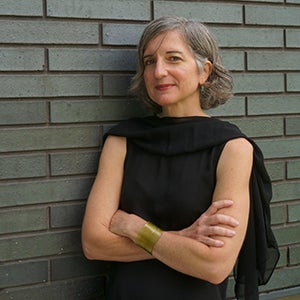Building the Future
Research briefs from Rice Architecture
Spring 2024
By Emily Hynds
Rice Architecture offers a close-knit community that provides both undergraduates and graduates with thoughtful instruction, particularly in the studio setting, while its position within a top-tier university allows the program to draw extensively from other disciplines to forge into new territories of speculative practice.

Practicing in Duality
There is a duality to architect Troy Schaum’s practice. “My work questions how architectural form impacts public space in the city,” he explains, “but I also do work related to historic restoration and preservation projects in art and cultural spaces.”
Schaum established Schaum/Shieh with fellow architect Rosalyne Shieh in 2009. They have designed projects in New York; Marfa, Texas; Houston; Los Angeles; and Virginia. Many of these are “design-forward environments,” such as art galleries, restaurants, music venues and public spaces. On the other side of the coin, Schaum/Shieh has been engaged in master planning and restoration work in Marfa for the Judd Foundation since 2012. They started by restoring Donald Judd’s Art Studio and Las Casas, one of the artist’s ranch houses in the Chinati Mountains; more recently, they restored the grounds and winter garden at the Block, Judd’s home in downtown Marfa.
“On the one hand, you have the space of speculation and projection, and on the other, the space of restraint and contemplation,” Schaum says. “They complement each other.”
Since 2019, Schaum and Shieh have been restoring Judd’s Architecture Office. When they were just weeks away from completion in 2021, a fire destroyed 80% of the building, morphing the project from restoration into a rebuild.
In 2022, for the Chinati Foundation, Schaum/Shieh restored the John Chamberlain building, home to 25 of Chamberlain’s sculptures. Chamberlain is best known for his abstract sculptures of crushed car parts, and this permanent exhibit is one of the largest in the world. The pair’s ongoing work in Marfa also includes the restoration of the Chinati Foundation’s two former artillery sheds, which house Judd’s iconic 100 untitled works in mill aluminum.
A key aspect of the work in Marfa is to preserve the historic buildings and the artwork inside them using as little energy as possible. Rather than air conditioning the spaces, Schaum and Shieh use passive systems, like harnessing the desert’s night air, to keep the spaces cool and reduce humidity.

“Houston has 150,000 structures in the 100-year flood plain, and we know the water is coming.”
Architect Albert Pope and anthropologist Dominic Boyer, along with students in Rice Architecture’s design studios, are designing a plan to restore Houston’s natural flood plains. The plan includes phased buyouts of properties in danger of flooding along the bayous, the restoration of the natural flood plain, and higher density living nearby.
The project aims to make the most of Houston’s Bayou Greenways, a city-owned network of 150 miles of interconnected bayou trails. Collaboration between the city, the Harris County Flood Control District (which would ultimately fund the buyouts), and the affected neighborhoods is key. Pope and Boyer have been working on this issue for a decade, and a grant from the National Science Foundation has funded the project for the next three years.
Pope and Boyer use the architecture design studios to collaborate with students on the legwork. During the research and community outreach phases, they engage with the local Super Neighborhoods — city-sanctioned conglomerates of neighborhood groups and associations dedicated to advocating for their communities — and map the floodplain along with the homes it contains. Houston ZIP codes are home to some of the highest rates of repeated flood insurance payments in the country, but government buyouts of these homes are rare.
Next, Pope, Boyer and the students create plans for phased buyouts of the areas along the bayous, which will take place over years and even decades. This lengthy process means residents can stay in their homes while higher density living is built nearby, allowing them to remain in the neighborhood when they do relocate. Finally, the designs undergo review and are presented to the community to use as tools in their fight against rising waters, gentrification and displacement.
One and a half million Houstonians live within walking distance of a bayou. Pope and Boyer believe that transforming Houston’s culture of construction from one focused on freeways to one focused on waterways could decrease flooding, increase walkability, reduce heat islands, restore natural water retention and enable the city’s complex bayou ecosystems to thrive.

Designing for the Gulf Coast
Architect Maggie Tsang focuses on climate adaptation, flood plain urbanism, community resilience, and the relationship between city and nature. The co-founder of Dept., a landscape architecture and urban design studio based in Houston and serving the Gulf Coast, she created “Prairie Plots,” a living installation next to the Turrell Skyspace, in 2022. Comprising more than 1,300 hardy plants and seeds known to thrive in the often harsh Houston climate, “Prairie Plots” serves as an example of how institutions can reimagine their footprint, letting changing climates guide the way humans interface with design.

Body-Plus
Architect Dawn Finley ’99 is investigating the implications of the body in design through her seminar Body-Plus: Architecture, Design and Disability, supported by a Rice BRIDGE (Building Research on Inequality and Diversity to Grow Equity) grant. “Disability in design is too often dealt with through code compliance rather than through a conceptual framework or starting point,” Finley says. The seminar focuses on interactive objects and smaller public buildings, reimagining codes, regulations and compliance not as limitations, but as a catalyst for possibility. “We can’t design for everyone; that’s impossible,” Finley says. “But we can contemplate nonstandard bodies for a broader audience.”
The BRIDGE grant for Body-Plus enables Finley to bring in three guest lecturers and pay for design project materials. Bess Williamson, a professor of art history, theory and criticism at the Art Institute of Chicago, recently led a workshop on product design and universal design, a discipline that operates through the lens of mobility and sensory disabilities. Students will also hear from Alan Russell, Rice’s director of disability.
Finley encourages students to incorporate direct commentary from members of the disabled community, who have been adapting, designing and engineering their own products since the beginning of time. Incorporating design for a wide range of bodies is not a limitation, she argues: It presents possibilities such as reimagined, and even perhaps beautiful, access ramps and other adaptive technology.
